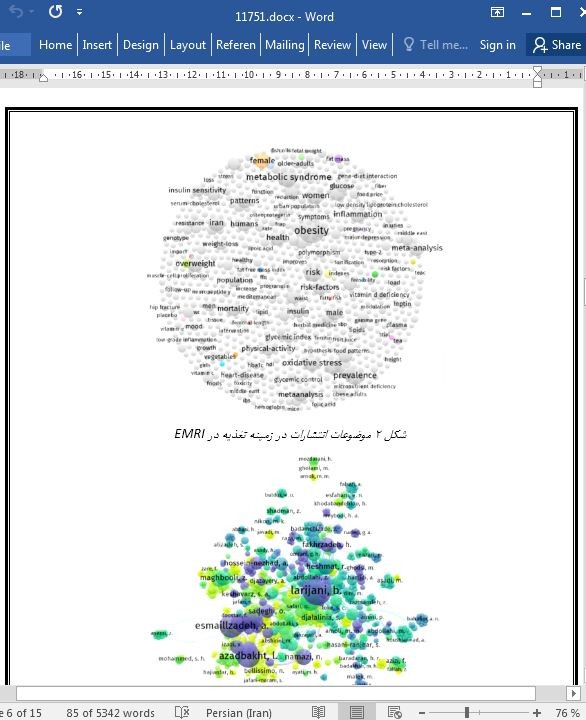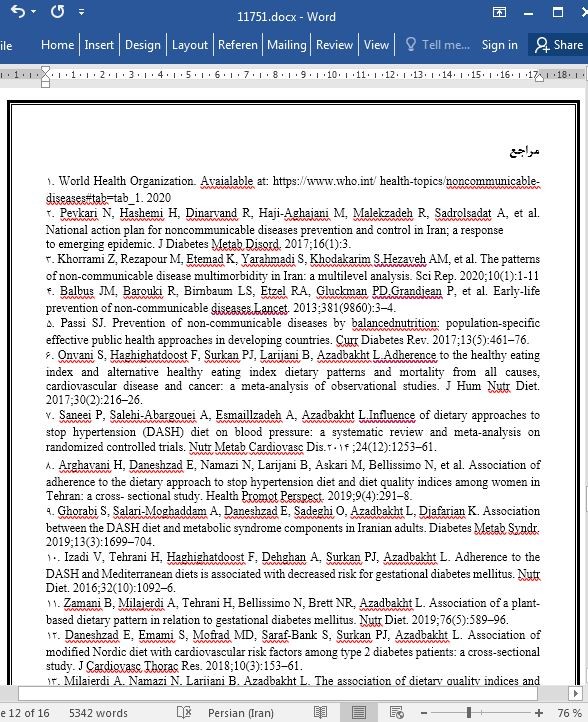
روند تحقیقات تغذیه ای در اختلالات غدد درون ریز، کاستی ها و برنامه های آینده
چکیده
پیش زمینه: تغذیه نقش موثری در پیشگیری و درمان بیماری های غدد دارد. هدف از این مطالعه ایجاد فرصتی برای بیان تجربیات 25 ساله مرکز تحقیقات غدد و متابولیسم (EMRI) و کاستی ها و برنامه های آینده در زمینه تغذیه و اختلالات غدد درون ریز بود.
روش ها: از زمان آغاز یکم دسامبر 2019 پایگاه های الکترونیکی شامل PubMed /Medline ، Web of Science و Scopus برای جمع آوری مقالات مربوط به مرکز تحقیقات غدد و متابولیسم در زمینه تغذیه تحت جستجو قرار گرفتند. مقالات جستجو شده هم به زبان فارسی و هم به زبان انگلیسی بودند. ورژن 1.16.13 برنامه landscape (VOS viewer) برای تهیه آمار های کتاب سنجی مورد استفاده قرار گرفت.
نتایج: از 4082 مطالعه مشخص شده در جستجوی اولیه، 319 مقاله مرتبط وارد مطالعه شده بود. از بین این 319 مقاله، 76 مقاله به روش مرور سیستماتیک و متا آنالیز ، 58 مقاله به روش آزمایشات بالینی، 171 مورد به روش مقطعی، 11 مورد به روش مورد شاهدی و 3 مورد به روش مطالعه بر روی حیوانات بودند. بر این اساس بیشتر مطالعات تغذیه ای در سطح 3 شواهد (مقالات مقطعی: 53.60 درصد) و به دنبال آن ها مقالات مروری سیستماتیک (23.82 درصد) با سطح شواهد 1 بودند. همچنین در طی سال ها روند افزایشی در مطالعات تغذیه ای مشاهده می شد که در سال 2019 به اوج خود رسید.
نتیجه گیری: روند افزایشی در انتشار مقالات حوزه علوم تغذیه در مرکز تحقیقات غدد و متابولیسم مشاهده می شود. با این حال تحقیقات و مقالات مربوط به حوزه تغذیه می توانند از طریق گسترش همکاری با رشته های دیگر مربوط به غدد، رشد بیشتری داشته باشند. با توجه به ارزیابی ها تغذیه ای در پروژه های ملی و تمرکز بر شناسایی روش های تغذیه ای پیشگیرانه، در نظر گرفتن شرایط جامعه ما می تواند مفید باشد تا یافته های تغذیه ای عملی تر شود.
مقدمه
طبق گزارشات سازمان جهانی بهداشت (WHO) بیماری های غیر واگیردار (NCDs) عامل اصلی مرگ و میر در سرتاسر جهان هستند[1]. در 20 سال گذشته مرگ ناشی از بیماری های غیر واگیردار اعم از بیماری های قلبی عروقی، دیابت و چاقی در ایران 20 درصد افزایش یافته است [2]. بنابراین سیاست گذاران برای کاهش بار اقتصادی، اجتماعی و روانی این گونه بیماری ها باید توجه ویژه ای به شناسایی روش های های پیشگیرانه داشته باشند [2و3]. اقدامات روش های پیشگیرانه بر روی چهار مورد اصلی شامل فعالیت جسمانی، استفاده از تنباکو، مصرف الکل و رژیم غذایی متمرکز است [4]. بعلاوه الگوهای رژیم غذایی سالم و تغییر عادات غذایی ناسالم به عادات غذایی پیشنهاد شده می تواند در پیشگیری و درمان شمار زیادی از بیماری ها مانند بیماری غدد درون ریز مفید باشد [5].
نتیجه گیری
روند افزایشی در انتشارات مربوط به تحقیقات تغذیه تحقیق مشاهده شده است. با این حال، فعالیت های تغذیه ای و انتشارات از طریق گسترش همکاری ها با سایر زمینه های مربوط به غدد درون ریز می توانند رشد بیشتری داشته باشند. با توجه به ارزیابی های تغذیه ای در پروژه های داخلی و تمرکز بر شناسایی استراتژی های ویژه تغذیه ای پیشگیرانه، در جامعه ما می تواند چگونگی جلوگیری از NCD را تبیین کرده و باعث کاهش بار اینگونه بیماری ها آن شود.
Abstract
Background Nutrition plays a pivotal role in the prevention and treatment of endocrine disorders. The aim of this study was to provide a window in order to display the 25-year activities of Endocrinology & Metabolism Research Institute (EMRI), and the gaps and future plans in the field of nutrition and endocrine disorders.
Methods To collect papers affiliated to the EMRI in field of nutrition from the inception to December 1st 2019, the electronic databases including PubMed/Medline, Web of Science, and Scopus were searched. Publications in English and Persian languages were included. Scientific Landscapes (VOS viewer) software version 1.6.13 was used to provide bibliometric maps.
Results Of 4082 studies identified in the initial search, 319 relevant papers were included. They contributed systematic review and meta-analysis/review (n = 76), clinical trials (n = 58), cross-sectional (n = 171), case-control studies (n = 11), and animal studies (n = 3). Accordingly, most nutrition studies were dedicated to the level of evidence III (cross-sectional studies: 53.60%) followed by systematic review studies (23.82%) with the level of evidence I. There was also an increasing trend in the nutrition studies through years, with a peak in 2019.
Conclusion An increasing trend in the publications related to nutrition science is observed at EMRI. However, nutrition research and publications can grow further through expanding collaborations with other fields related to endocrine. Given nutritional assessments in national projects and focusing on the identification of preventive nutritional strategies, considering the situations of our society can be helpful to make nutritional findings more practical.
Introduction
Based on the report published by the World Health Organization (WHO), non-communicable diseases (NCDs) represent the leading cause of mortality across the world [1]. In the past 20 years, NCD deaths including cardiovascular diseases, diabetes, and obesity have increased by 14.5% in Iran [2]. Therefore, policy makers need to pay specific attention to identifying preventive strategies in order to reduce economic, social, and psychological burden of such diseases [2, 3]. Prevention efforts focus on the four main factors including physical activity, tobacco use, alcohol consumption, and diet [4]. Adherence to healthy dietary patterns and changing from unhealthy eating habits to recommended ones can be helpful in preventing and treating a wide range of diseases including endocrine disorders [5].
Conclusion
An increasing trend in the publications related to nutrition research is observed. However, nutrition activities and publications can grow further through expanding collaborations with other fields related to endocrine. Considering nutritional assessments in national projects and focusing on the identification of preventive nutritional strategies specific to our society can shed light on how to prevent NCDs and decrease the burden of such diseases.
چکیده
مقدمه
روش ها
نتایج
جستجو منبعی
مشخصات اصلی مطالعات مشمول
یافته های بررسی های سیستماتیک و متا آنالیز
یافته های تحقیقات ملی تغذیه
فعالیت های دیگر
فعالیت ها در زمینه ویروس همه گیر کووید 19 (پاندمی)
بحث
نتیجه گیری
مراجع
Abstract
Introduction
Methods
Results
Literature search
Main characteristics of the included studies
Findings of systematic reviews and meta-analyses
Findings of national nutritional research
Other activities
Activities in the COVID-19 pandemic
Discussion
Conclusion
References
- اصل مقاله انگلیسی با فرمت ورد (word) با قابلیت ویرایش
- ترجمه فارسی مقاله با فرمت ورد (word) با قابلیت ویرایش، بدون آرم سایت ای ترجمه
- ترجمه فارسی مقاله با فرمت pdf، بدون آرم سایت ای ترجمه



